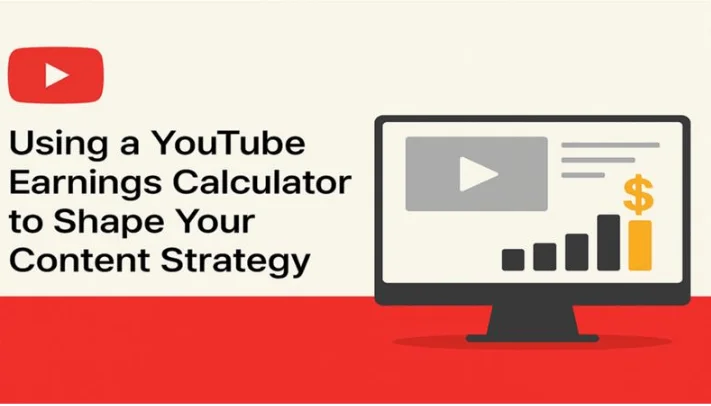A YouTube earnings calculator is a powerful tool that estimates how much revenue creators can make from their videos based on views, engagement, and ad performance. Many creators wonder if their current content choices truly match their monetization goals, or if small adjustments could increase income without alienating their audience. The answer lies in understanding how revenue potential works at a deeper level.
Understanding the YouTube Money Calculator
The YouTube money calculator is designed to transform your analytics into clear financial projections. It estimates potential income based on CPM (cost per thousand views) and engagement rates, giving creators a realistic picture of possible ad revenue. By entering average monthly views, creators can see how shifts in content type or posting frequency may change their earnings.
For instance, a tech channel receiving 200,000 monthly views can compare how tutorial videos perform compared to trending product reviews. If the calculator shows that product reviews yield a higher CPM, the creator can adjust content planning accordingly. This type of insight takes the guesswork out of monetization, replacing vague expectations with measurable targets that help guide editorial decisions.
Why Earnings Projections Matter for Content Strategy
Earnings projections are essential for aligning creative work with business outcomes. Many content creators produce content they enjoy without considering the revenue potential of different niches. However, CPM rates vary significantly. A video in the finance niche may generate three times more ad revenue than an entertainment vlog with identical views.
Understanding these variations allows creators to make better decisions about which topics to prioritize. For example, a lifestyle creator could maintain their brand identity while introducing higher-value content like product comparisons or trend analyses to raise CPM. The calculator’s projections help balance audience satisfaction with sustainable profitability, ensuring the channel grows in both influence and income.
Analyzing Audience Engagement for Better Forecasts
Engagement is one of the most important factors affecting monetization. Metrics like watch time, likes, comments, and shares all influence advertiser confidence and ad placement. A calculator can only provide accurate projections if the engagement data entered reflects actual audience behavior.
Consider a travel channel that consistently achieves 150,000 monthly views but has an average watch duration of just two minutes. Low retention reduces CPM potential. By improving narrative pacing, editing transitions, and adding stronger hooks at the start of videos, the creator can increase retention. Higher engagement not only boosts algorithmic reach but also raises the revenue per thousand views. When these updated engagement metrics are entered into the calculator, the earnings forecast becomes more optimistic—and more realistic.
Using the Calculator to Test New Content Ideas
The earnings calculator is more than just a reporting tool; it can be used proactively to test content ideas before production. This prevents wasted time on low-performing formats and allows creators to allocate energy to videos with higher earning potential.
A gaming channel, for example, could use the calculator to project revenue from different types of content: short highlight clips, live stream recaps, or deep-dive reviews. By comparing CPM values and engagement projections for each, the creator can decide which style offers the best balance of audience interest and revenue. This planning process supports both creative experimentation and financial stability.
Integrating Earnings Data into Long-Term Strategy
A sustainable content strategy requires balancing creative goals with financial performance. Earnings data from the calculator helps shape long-term plans, guiding decisions about upload schedules, production investments, and brand collaborations.
For instance, if a creator finds that a particular playlist generates consistently high CPM and strong engagement, they may choose to expand that playlist into a regular series or create spin-off content. Similarly, consistent data can help determine when it makes sense to invest in higher production quality or advertising to grow the audience further. Using calculator insights over time ensures that each decision supports both growth and revenue objectives.
Common Pitfalls When Relying on the Calculator
While a YouTube earnings calculator is an excellent resource, it should not be treated as a guarantee. CPM rates are influenced by multiple factors, including seasonality, audience demographics, and advertiser demand. Creators sometimes make the mistake of assuming CPM values will stay constant, which can lead to unrealistic expectations.
Another pitfall is focusing exclusively on high-CPM niches without considering whether the audience will respond well to the shift. A channel that abruptly changes from entertainment to finance content, for example, may lose existing subscribers. The calculator works best when used in combination with audience insights, channel branding considerations, and real-time YouTube Analytics to create a balanced, adaptable strategy.
FAQs
How accurate is a YouTube earnings calculator?
It provides estimates based on the information entered. CPM values can vary over time and by niche, so projections should be treated as guidelines, not exact predictions.
Can small channels benefit from using the calculator?
Absolutely. Even smaller channels can use projections to identify profitable niches, refine their video topics, and set realistic monetization targets.
Does the calculator include revenue from sponsorships?
No. Most calculators focus solely on ad-based revenue. Sponsorship and affiliate income should be calculated separately but can be informed by CPM trends.
How often should creators check their earnings projections?
Monthly or quarterly checks work well, especially when experimenting with new formats or noticing changes in engagement metrics.
Is it possible to increase CPM rates deliberately?
Yes. Choosing higher-value topics, increasing watch time, and targeting audiences from regions with stronger advertiser competition can all raise CPM potential.










 /home/u448362301/domains/theexpotab.com/public_html/wp-content/themes/foxiz/templates/popup.php on line 167
/home/u448362301/domains/theexpotab.com/public_html/wp-content/themes/foxiz/templates/popup.php on line 167